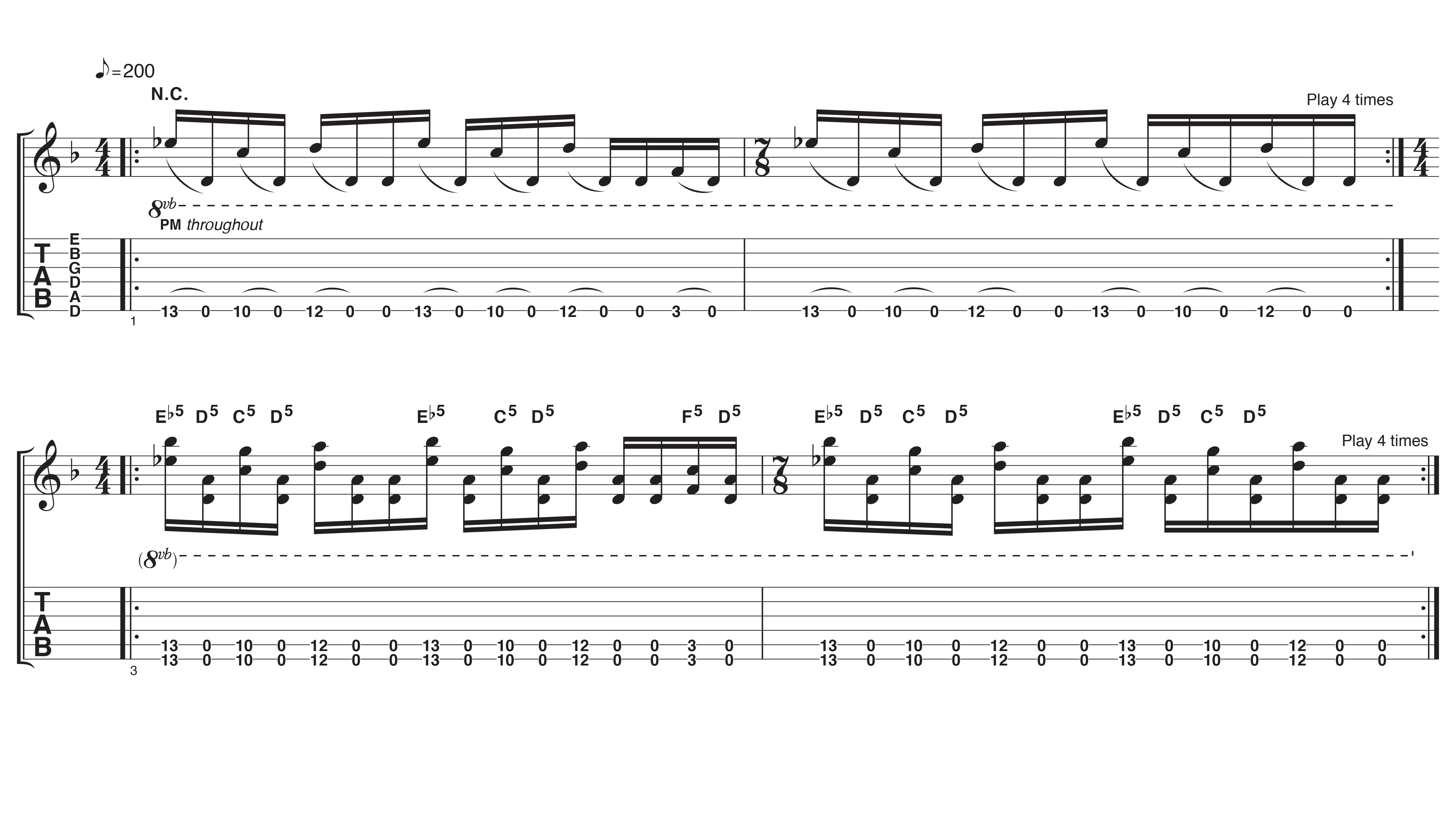Tool guitar lesson: 5 ways to play like Adam Jones
Get Tooled up with swells, open string drones, powerchords, triplets and more with this tab and audio lesson

In celebration of the announcement of Tool's 2022 tour dates in the (much-delayed) support of the Fear Inoculum album, we’re looking at some of Adam Jones’s trademark techniques as heard on the album as well as throughout Tool’s back catalogue.
Drop D tuning (DADGBE from low to high) is an essential part of the Tool sound – simply down-tune your guitar’s sixth string by two semitones. Adam occasionally uses drop B (B F# B E G# C#), but we’ve stayed with the more common drop D so you don’t have to down-tune your whole guitar.
This results in a nice easy way to play powerchords on the lower strings, which you can see in our Stinkfist inspired first example. Next we use those powerchord shapes with volume swells and venture into some open string drones for a Fear Inoculum atmosphere.
From there we cover tight, palm-muted triplet hammer-ons as heard in Schism and Vicarious, as well as a heavy Forty Six & 2 style pedal riff.
Finally we’re looking at some Rosetta Stoned influenced syncopation – complex rhythms which will require careful practice.
Click in the top right of the tab examples to enlarge
1. Drop D tuned powerchords
Play the G5 and F5 powerchords with a first finger barre, then add the sus2 interval with your third finger on the fourth string. Keep your strumming hand moving down
Want all the hottest music and gear news, reviews, deals, features and more, direct to your inbox? Sign up here.
and up throughout and use your fretting hand to mute the strings where you see ‘X’s in the tab.
TIP: Make a fist of drop D chords

In drop D tuning, powerchords can be played with just one finger barring across the three bass strings. Easy! And for an epic sus2 chord, try adding your third finger to the fourth string.
Also pretty easy! These are staple shapes in contemporary rock, metal and prog, and Adam Jones has used them numerous times with Tool. Consider these shapes essential.
2. Ambient volume swells
Start with your volume knob turned down then strum each chord before raising the volume to fade in. Add reverb or delay for extra sustain; we’ve added a panning delay effect set to a dotted eighth note rhythm.
In bars 3 and 4 allow the two strings to ring together and keep your delay pedal engaged.
3. Palm muted triplets
This riff is palm-muted throughout so keep your palm resting lightly on the bridge; your picked notes and hammer-ons should sound as similar as possible in tone and volume. The coordination between the left and right hand is key, so practise slowly to make sure the notes are even before speeding up.
Tip: Three-note-per-string D minor pentatonic scale

This is a cool way to play the D minor pentatonic scale in drop D tuning – an approach you’ll find used in Schism and Vicarious. The idea is to pick an open string then hammer on to two more notes on the same string. Opt for a triplet feel (a three-note grouping) for a typical Adam Jones-style riff.
4. Alternating time signatures
In bar 1, pick all the fretted notes, then follow up each one with a pull-off to the open D root note. Once you have learnt bar 1 (in 4/4 time), bar 2 (in 7/8) is essentially the same thing with the final two notes missing. After four repeats, the riff changes to weighty powerchords for a heavier sound.
Tip: Counting odd time

Playing in odd time signatures is strange at first but becomes easier if you compare the signature to the good old familiar feel of 4/4 – the most common time signature in all rock and pop.
Here you can see that a bar of 7/8 time is just one eighth note shorter than 4/4. Simply follow our counts to keep in time.
5. Cross rhythms
In 4/4, two bars contain 16 eighth notes and these can be divided up however any riff writer chooses – an idea that Tool explore a lot. Our riff has five eighth-notes (played three times), followed by one eighth-note (played once). Count ‘1 2 3 4 5, 1 2 3 4 5, 1 2 3 4 5, 1’ to keep time.
For more of a challenge the bass and drums move out of sync by one eighth note in bars 3 and 4 – the ultimate foot tapping challenge!
5 songs drummers need to hear featuring… Tool's Danny Carey
Total Guitar is Europe's best-selling guitar magazine.
Every month we feature interviews with the biggest names and hottest new acts in guitar land, plus Guest Lessons from the stars.
Finally, our Rocked & Rated section is the place to go for reviews, round-ups and help setting up your guitars and gear.
Subscribe: http://bit.ly/totalguitar





